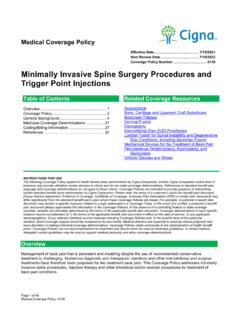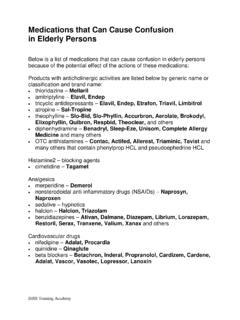Transcription of ANNEX I SUMMARY OF PRODUCT CHARACTERISTICS
1 1 ANNEX I SUMMARY OF PRODUCT CHARACTERISTICS 2 1. NAME OF THE MEDICINAL PRODUCT Cosentyx 75 mg solution for injection in pre-filled syringe 2. QUALITATIVE AND QUANTITATIVE COMPOSITION Each pre-filled syringe contains 75 mg secukinumab in ml. Secukinumab is a recombinant fully human monoclonal antibody produced in Chinese Hamster Ovary (CHO) cells. For the full list of excipients, see section 3. PHARMACEUTICAL FORM Solution for injection (injection) The solution is clear and colourless to slightly yellow. 4. CLINICAL PARTICULARS Therapeutic indications Paediatric plaque psoriasis Cosentyx is indicated for the treatment of moderate to severe plaque psoriasis in children and adolescents from the age of 6 years who are candidates for systemic therapy.
2 Juvenile idiopathic arthritis (JIA) Enthesitis-related arthritis (ERA) Cosentyx, alone or in combination with methotrexate (MTX), is indicated for the treatment of active enthesitis-related arthritis in patients 6 years and older whose disease has responded inadequately to, or who cannot tolerate, conventional therapy (see section ). Juvenile psoriatic arthritis (JPsA) Cosentyx, alone or in combination with methotrexate (MTX), is indicated for the treatment of active juvenile psoriatic arthritis in patients 6 years and older whose disease has responded inadequately to, or who cannot tolerate, conventional therapy (see section ). Posology and method of administration Cosentyx is intended for use under the guidance and supervision of a physician experienced in the diagnosis and treatment of conditions for which Cosentyx is indicated.
3 Posology Paediatric plaque psoriasis (adolescents and children from the age of 6 years) The recommended dose is based on body weight (Table 1) and administered by subcutaneous injection with initial dosing at weeks 0, 1, 2, 3 and 4, followed by monthly maintenance dosing. Each 75 mg dose is given as one subcutaneous injection of 75 mg. Each 150 mg dose is given as one subcutaneous injection of 150 mg. Each 300 mg dose is given as one subcutaneous injection of 300 mg or as two subcutaneous injections of 150 mg. 3 Table 1 Recommended dose for paediatric plaque psoriasis Body weight at time of dosing Recommended dose <25 kg 75 mg 25 to <50 kg 75 mg 50 kg 150 mg (*may be increased to 300 mg) *Some patients may derive additional benefit from the higher dose.
4 Juvenile idiopathic arthritis (JIA) Enthesitis-related arthritis (ERA) and juvenile psoriatic arthritis (JPsA) The recommended dose is based on body weight (Table 2) and administered by subcutaneous injection at weeks 0, 1, 2, 3, and 4, followed by monthly maintenance dosing. Each 75 mg dose is given as one subcutaneous injection of 75 mg. Each 150 mg dose is given as one subcutaneous injection of 150 mg. Table 2 Recommended dose for juvenile idiopathic arthritis Body weight at time of dosing Recommended dose <50 kg 75 mg 50 kg 150 mg Cosentyx may be available in other strengths and/or presentations depending on the individual treatment needs. For all of the above indications, available data suggest that a clinical response is usually achieved within 16 weeks of treatment.
5 Consideration should be given to discontinuing treatment in patients who have shown no response by 16 weeks of treatment. Some patients with an initial partial response may subsequently improve with continued treatment beyond 16 weeks. The safety and efficacy of Cosentyx in children with plaque psoriasis and in the juvenile idiopathic arthritis (JIA) categories of ERA and JPsA below the age of 6 years have not been established. The safety and efficacy of Cosentyx in children below the age of 18 years in other indications have not yet been established. No data are available. Special populations Renal impairment / hepatic impairment Cosentyx has not been studied in these patient populations.
6 No dose recommendations can be made. Method of administration Cosentyx is to be administered by subcutaneous injection. If possible, areas of the skin that show psoriasis should be avoided as injection sites. The syringe must not be shaken. After proper training in subcutaneous injection technique, patients may self-inject Cosentyx or be injected by a caregiver if a physician determines that this is appropriate. However, the physician should ensure appropriate follow-up of patients. Patients or caregivers should be instructed to inject the full amount of Cosentyx according to the instructions provided in the package leaflet. Comprehensive instructions for administration are given in the package leaflet.
7 Contraindications Hypersensitivity to the active substance or to any of the excipients listed in section Clinically important, active infection, active tuberculosis (see section ). 4 Special warnings and precautions for use Traceability In order to improve the traceability of biological medicinal products, the name and the batch number of the administered PRODUCT should be clearly recorded. Infections Secukinumab has the potential to increase the risk of infections. Serious infections have been observed in patients receiving secukinumab in the post-marketing setting. Caution should be exercised when considering the use of secukinumab in patients with a chronic infection or a history of recurrent infection.
8 Patients should be instructed to seek medical advice if signs or symptoms suggestive of an infection occur. If a patient develops a serious infection, the patient should be closely monitored and secukinumab should not be administered until the infection resolves. In clinical studies, infections have been observed in patients receiving secukinumab (see section ). Most of these were mild or moderate upper respiratory tract infections such as nasopharyngitis and did not require treatment discontinuation. Related to the mechanism of action of secukinumab, non-serious mucocutaneous candida infections were more frequently reported for secukinumab than placebo in the psoriasis clinical studies ( per 100 patient years for secukinumab 300 mg versus per 100 patient years for placebo) (see section ).
9 No increased susceptibility to tuberculosis was reported from clinical studies. However, secukinumab should not be given to patients with active tuberculosis. anti -tuberculosis therapy should be considered prior to initiation of secukinumab in patients with latent tuberculosis. inflammatory bowel disease (including Crohn s disease and ulcerative colitis) Cases of new or exacerbations of inflammatory bowel disease have been reported with secukinumab (see section ). Secukinumab is not recommended in patients with inflammatory bowel disease. If a patient develops signs and symptoms of inflammatory bowel disease or experiences an exacerbation of pre-existing inflammatory bowel disease, secukinumab should be discontinued and appropriate medical management should be initiated.
10 Hypersensitivity reactions In clinical studies, rare cases of anaphylactic reactions have been observed in patients receiving secukinumab. If an anaphylactic or other serious allergic reactions occur, administration of secukinumab should be discontinued immediately and appropriate therapy initiated. Latex-sensitive individuals The removable needle cap of Cosentyx 75 mg solution for injection in pre-filled syringe contains a derivative of natural rubber latex. No natural rubber latex has to date been detected in the removable needle cap. Nevertheless, the use of Cosentyx 75 mg solution for injection in pre-filled syringe in latex-sensitive individuals has not been studied and there is therefore a potential risk of hypersensitivity reactions which cannot be completely ruled out.















